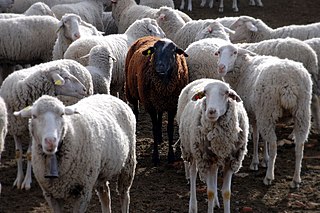The out-group homogeneity effect is the perception of out-group members as more similar to one another than are in-group members, e.g. "they are alike; we are diverse". Perceivers tend to have impressions about the diversity or variability of group members around those central tendencies or typical attributes of those group members. Thus, outgroup stereotypicality judgments are overestimated, supporting the view that out-group stereotypes are overgeneralizations. The term "outgroup homogeneity effect", "outgroup homogeneity bias" or "relative outgroup homogeneity" have been explicitly contrasted with "outgroup homogeneity" in general, the latter referring to perceived outgroup variability unrelated to perceptions of the ingroup.
In-group favoritism, sometimes known as in-group–out-group bias, in-group bias, intergroup bias, or in-group preference, is a pattern of favoring members of one's in-group over out-group members. This can be expressed in evaluation of others, in allocation of resources, and in many other ways.

In sociology and social psychology, an in-group is a social group to which a person psychologically identifies as being a member. By contrast, an out-group is a social group with which an individual does not identify. People may for example identify with their peer group, family, community, sports team, political party, gender, sexual orientation, religion, or nation. It has been found that the psychological membership of social groups and categories is associated with a wide variety of phenomena.
System justification theory is a theory within social psychology that system-justifying beliefs serve a psychologically palliative function. It proposes that people have several underlying needs, which vary from individual to individual, that can be satisfied by the defense and justification of the status quo, even when the system may be disadvantageous to certain people. People have epistemic, existential, and relational needs that are met by and manifest as ideological support for the prevailing structure of social, economic, and political norms. Need for order and stability, and thus resistance to change or alternatives, for example, can be a motivator for individuals to see the status quo as good, legitimate, and even desirable.
The minimal group paradigm is a method employed in social psychology. Although it may be used for a variety of purposes, it is best known as a method for investigating the minimal conditions required for discrimination to occur between groups. Experiments using this approach have revealed that even arbitrary distinctions between groups, such as preferences for certain paintings, or the color of their shirts, can trigger a tendency to favor one's own group at the expense of others, even when it means sacrificing in-group gain.
Stephen Alexander "Alex" Haslam is a professor of psychology and ARC Australian Laureate Fellow in the School of Psychology at the University of Queensland.

Henri Tajfel was a Polish social psychologist, best known for his pioneering work on the cognitive aspects of prejudice and social identity theory, as well as being one of the founders of the European Association of Experimental Social Psychology.

In the English language, black sheep is an idiom that describes a member of a group who is different from the rest, especially a family member who does not fit in. The term stems from sheep whose fleece is colored black rather than the more common white; these sheep stand out in the flock and their wool is worth less as it will not dye.
Stephen David Reicher is Bishop Wardlaw Professor of Social Psychology at the University of St Andrews.
Optimal distinctiveness is a social psychological theory seeking to understand ingroup–outgroup differences. It asserts that individuals desire to attain an optimal balance of inclusion and distinctiveness within and between social groups and situations. These two motives are in constant opposition with each other; when there is too much of one motive, the other must increase in order to counterbalance it and vice versa. The theory of optimal distinctiveness was first proposed by Dr. Marilynn B. Brewer in 1991 and extensively reviewed in 2010 by Drs. Geoffrey J. Leonardelli, Cynthia L. Pickett, and Marilynn Brewer.
Self-categorization theory is a theory in social psychology that describes the circumstances under which a person will perceive collections of people as a group, as well as the consequences of perceiving people in group terms. Although the theory is often introduced as an explanation of psychological group formation, it is more accurately thought of as general analysis of the functioning of categorization processes in social perception and interaction that speaks to issues of individual identity as much as group phenomena. It was developed by John Turner and colleagues, and along with social identity theory it is a constituent part of the social identity approach. It was in part developed to address questions that arose in response to social identity theory about the mechanistic underpinnings of social identification.

In social psychology, a stereotype is a generalized belief about a particular category of people. It is an expectation that people might have about every person of a particular group. The type of expectation can vary; it can be, for example, an expectation about the group's personality, preferences, appearance or ability. Stereotypes are often overgeneralized, inaccurate, and resistant to new information. A stereotype does not necessarily need to be a negative assumption. They may be positive, neutral, or negative.
In social psychology, self-stereotyping is a process by which an individual integrates and internalizes commonly held characterizations of an in-group into their self-concept. It is described as part of social identity theory (SIT) and, more specifically, self-categorization theory (SCT).

"Social identity approach" is an umbrella term designed to show that there are two methods used by academics to describe certain complex social phenomena- namely the dynamics between groups and individuals. Those two theoretical methods are called social identity theory and self-categorization theory. Experts describe them as two intertwined, but distinct, social psychological theories. The term "social identity approach" arose as an attempt to mitigate against the tendency to conflate the two theories, as well as the tendency to mistakenly believe one theory to be a component of the other. These theories should be thought of as overlapping. While there are similarities, self categorisation theory has greater explanatory scope and has been investigated in a broader range of empirical conditions. Self-categorization theory can also be thought of as developed to address limitations of social identity theory. Specifically the limited manner in which social identity theory deals with the cognitive processes that underpin the behaviour it describes. Although this term may be useful when contrasting broad social psychological movements, when applying either theory it is thought of as beneficial to distinguish carefully between the two theories in such a way that their specific characteristics can be retained.
John Charles Turner was a British social psychologist who, along with colleagues, developed the self-categorization theory. Amongst other things, the theory states that the self is not a foundational aspect of cognition, but rather that the self is an outcome of cognitive processes and an interaction between the person and the social context. The self-categorization theory was developed as a companion theory to the social identity theory, and the two theories taken together are known as the social identity approach.
Collective self-esteem is a concept originating in the field of psychology that describes the aspect of an individual's self-image that stems from how the individual interacts with others and the groups that the individual is a part of. The idea originated during the research of Jennifer Crocker, during which she was trying to learn about the connection between a person's self-esteem and their attitude towards or about the group that the person is part of.
There is a great deal of research on the factors that lead to the formation of prejudiced attitudes and beliefs. There is also a lot of research on the consequences of holding prejudiced beliefs and being the target of such beliefs. It is true that advances have been made in understanding the nature of prejudice. A consensus on how to end prejudice has yet to be established, but there are a number of scientifically examined strategies that have been developed in attempt to solve this social issue.
Intergroup relations refers to interactions between individuals in different social groups, and to interactions taking place between the groups themselves collectively. It has long been a subject of research in social psychology, political psychology, and organizational behavior.
In social psychology, social projection is the psychological process through which an individual expects behaviors or attitudes of others to be similar to their own. Social projection occurs between individuals as well as across ingroup and outgroup contexts in a variety of domains. Research has shown that aspects of social categorization affect the extent to which social projection occurs. Cognitive and motivational approaches have been used to understand the psychological underpinnings of social projection as a phenomenon. Cognitive approaches emphasize social projection as a heuristic, while motivational approaches contextualize social projection as a means to feel connected to others. In contemporary research on social projection, researchers work to further distinguish between the effects of social projection and self-stereotyping on the individual’s perception of others.
Social identity threat is a theory in social psychology derived from social identity theory to explain the different types of threats that arise from group identity being threatened as opposed to personal identity. This theory distinguishes between four distinct types of social identity threats: categorization threat, distinctiveness threat, threats to the value of social identity, and acceptance threat. Each type is associated with particular social contexts that make the threats more or less likely to occur. This theory emphasizes how the level of commitment with the social identity shapes the nature of the threat experienced.








